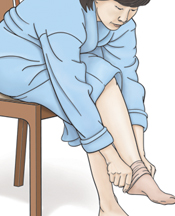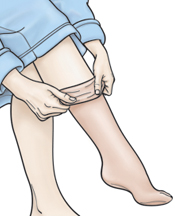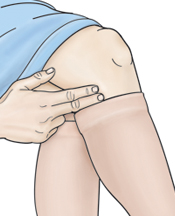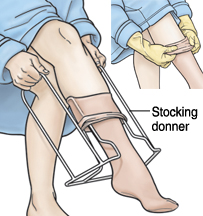Elastic compression stockings are prescribed to treat many vein problems. Wearing them may be the most important thing you do to manage your symptoms. The stockings fit tightly around your ankle, gradually reducing in pressure as they go up your legs. This helps keep blood flowing to your heart. As a result, swelling is reduced. Your healthcare provider will prescribe stockings at a safe pressure for you. They will also tell you how often to wear and remove the stockings. Follow these instructions closely. Also, don't buy or wear compression stockings without first seeing your healthcare provider.
Tips for wear and care
To wear stockings safely and to get the most benefit:
-
Wear the length prescribed by your healthcare provider.
-
Pull them to the designated height and no farther. Don’t let them bunch at the top. This can restrict blood flow and increase swelling.
-
Wear the stockings for the amount of time your healthcare provider recommends. Replace them when they start to feel loose. This will likely be every 3 to 6 months.
-
Remove them as your healthcare provider directs. When removed, wash your legs. Then check your legs and feet for sores. Call your healthcare provider if you find a sore. Don’t put the stockings back on unless your healthcare provider directs you to.
-
Wash the stockings as instructed. They may need to be handwashed.






